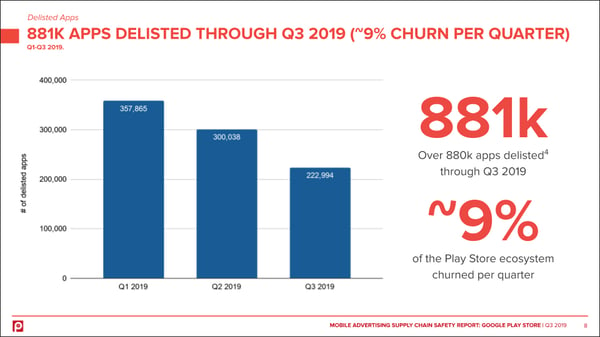
This week's review of ad fraud and quality in the digital advertising space.
How many apps are on the Google Play Store? Pixalate's 2019 Mobile Advertising Supply Chain Safety Report reveals that, as of the end of Q3 2019, the Play Store had over over 3.2 million apps.

Pixalate's 2019 Mobile Advertising Supply Chain Safety Report reveals that over 880,000 apps were delisted from the Google Play Store between Q1-Q3 2019.

"Historically, media observers called out the use of auto-refreshing ads as a bad practice, something geared to the short term and rather mercenary," wrote Digiday. "But this view is changing and the practice is hardly en route to extinction."
The article warns, however, that "when an auto-refreshing is rigged on a timer, regardless of other criteria, that’s when the practice wanders into fraud territory."

The Wall Street Journal has reported on new tactics used by scammers, with "some cybercriminals ... outfoxing Silicon Valley with software that is getting better at mimicking human behavior."

"TikTok ... had serious vulnerabilities that would have allowed hackers to manipulate user data and reveal personal information," reported the New York Times, citing research from Check Point. "The weaknesses would have allowed attackers to send TikTok users messages that carried malicious links," the NYT reported. "Once users clicked on the links, attackers would have been able to take control of their accounts, including uploading videos or gaining access to private videos."
*By entering your email address and clicking Subscribe, you are agreeing to our Terms of Use and Privacy Policy.
These Stories on Weekly Recaps
*By entering your email address and clicking Subscribe, you are agreeing to our Terms of Use and Privacy Policy.
Disclaimer: The content of this page reflects Pixalate’s opinions with respect to the factors that Pixalate believes can be useful to the digital media industry. Any proprietary data shared is grounded in Pixalate’s proprietary technology and analytics, which Pixalate is continuously evaluating and updating. Any references to outside sources should not be construed as endorsements. Pixalate’s opinions are just that - opinion, not facts or guarantees.
Per the MRC, “'Fraud' is not intended to represent fraud as defined in various laws, statutes and ordinances or as conventionally used in U.S. Court or other legal proceedings, but rather a custom definition strictly for advertising measurement purposes. Also per the MRC, “‘Invalid Traffic’ is defined generally as traffic that does not meet certain ad serving quality or completeness criteria, or otherwise does not represent legitimate ad traffic that should be included in measurement counts. Among the reasons why ad traffic may be deemed invalid is it is a result of non-human traffic (spiders, bots, etc.), or activity designed to produce fraudulent traffic.”

